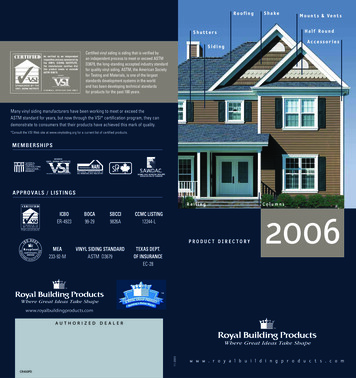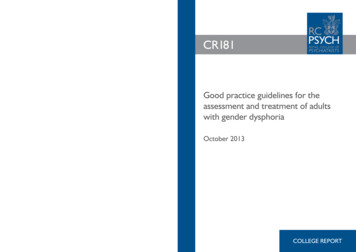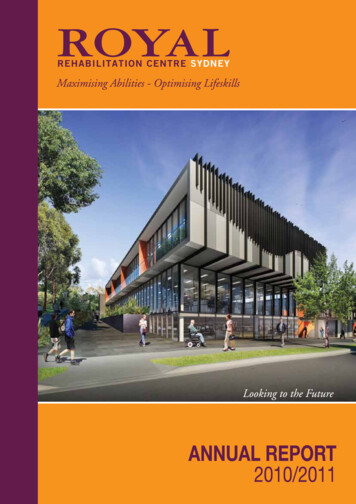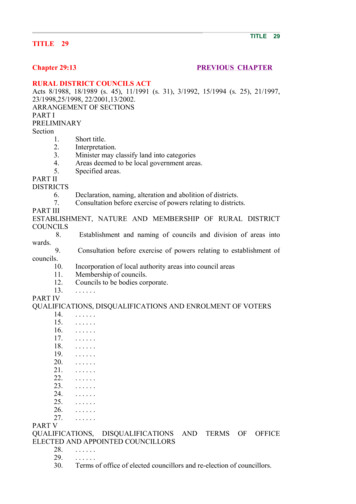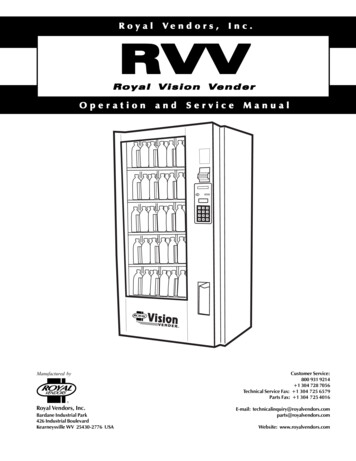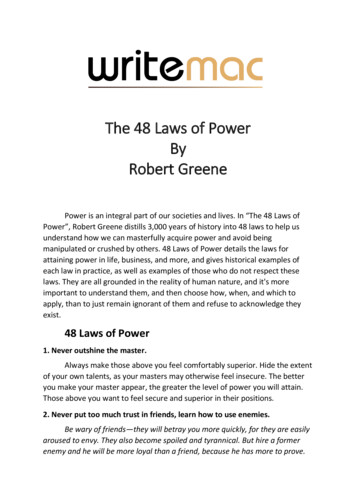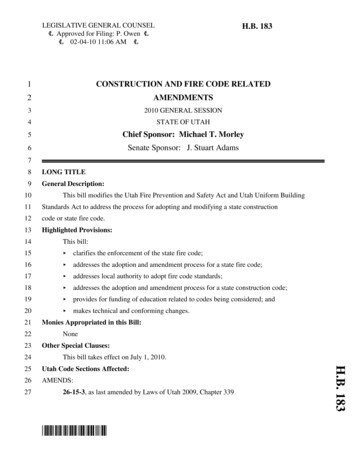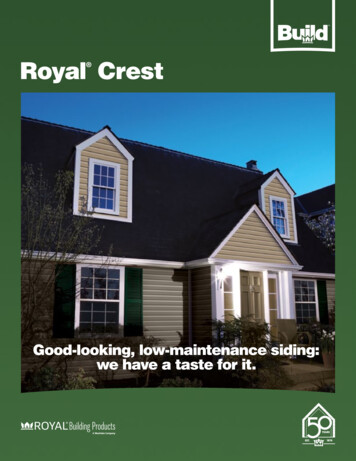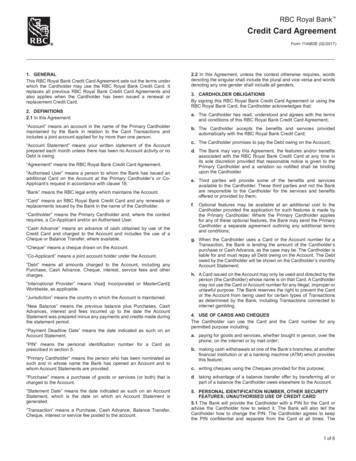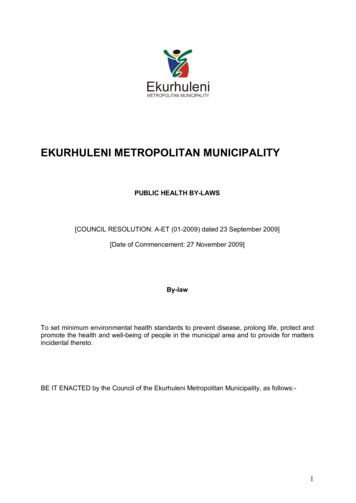
Transcription
EKURHULENI METROPOLITAN MUNICIPALITYPUBLIC HEALTH BY LAWS[COUNCIL RESOLUTION: A ET (01 2009) dated 23 September 2009][Date of Commencement: 27 November 2009]By lawTo set minimum environmental health standards to prevent disease, prolong life, protect andpromote the health and well being of people in the municipal area and to provide for mattersincidental thereto.BE IT ENACTED by the Council of the Ekurhuleni Metropolitan Municipality, as follows: 1
TABLE OF CONTENTSCHAPTER 1INTERPRETATION AND FUNDAMENTAL PRINCIPLES1.Definitions and interpretation2.PurposeCHAPTER 2PUBLIC HEALTHPart 1: Public health principles3.Principles4.Application of PrinciplesPart 2: Public health hazards and public health nuisances5.Prohibition on causing public health hazards6.Camping permits7.Duty to report public health hazards8.Prohibition on causing public health nuisancesCHAPTER 3POTENTIALLY HAZARDOUS USES OF PREMISES AND ENFORCEMENTPart 1: Potentially hazardous uses9.Duty to list potentially hazardous uses10.Scheduled uses11.Exemption certificates12.Public health permits13.Approval of measures, objects and materials14.Application procedure15.General terms applicable to certificates and permits16.Suspension, cancellation and amendment of exemption certificates and permitsPart 2: Enforcement, remedial work and costs17.Demolition orders18.Municipal remedial work19.Cost orders2
CHAPTER 4:SANITARY SERVICES20.Compulsory connection to municipal sewage system21.Prohibition against obstruction of sanitary services22.Requirements in respect of toiled facilities23.Toilets for workers24.Prohibition against use of a bucket toilet under the same roof as a dwelling25.Conditions of toilets, urinals, backyards and refuse areas26.Separate storage of urine27.Provision of tank for waste liquids in areas without sewers28.Pumping of contents of underground tank to surface tank29.Blocked or defective outlet pipes30.Prohibition against urine in slops tanksCHAPTER 5PRIVATE SEWAGE WORKS31.Permit for provision of service for the removal of human excrement or urine32.Permit for installation of sewage works33.Maintenance of sewage works34.Disposal of sewage, sewage effluent and wastewater without causing a public healthnuisance and/or hazard35.Compulsory use of Council’s sewage removal serviceCHAPTER 6WATER36.Definitions37.Pollution of sources of water supply38.Dangerous wells, boreholes and excavations39.Provision of adequate water supply40.Use of water form sources other than the municipal supply41.Furnishing of particulars of the source of water42.Notice of the sinking or digging of a boreholes or wells43.Storm water runoff from premises which may impact on public health44.Containment of waste water3
CHAPTER 7OFFENSIVE TRADES45.Definitions46.Permit requirement47.Requirement for premises48.Duties of offensive traders49.Liquid refuse from bone and tripe boiling50.Liquids, tanks and tubs in leather making51.Storage of rags, bones and wasteCHAPTER 8HAIRDRESSING, BEAUTY AND COSMETOLOGY SERVICES52.Definitions53.Permit requirement54.Requirement for premises55.Duties of salon operators56.Required minimum health standards for the operation of a salon57.Prohibition against the use of salon premises for other purposesCHAPTER 9SECOND HAND GOODS58.Definitions59.Requirements for premises60.Duties of second hand goods tradersCHAPTER 10ACCOMMODATION ESTABLISHMENTS61.Definitions62.Permit requirement63.Requirement for premises of accommodation establishments64.Duties of operators of accommodation establishmentsCHAPTER 11DRY CLEANING AND LAUNDRY ESTABLISHMENTS65.Definitions66.Premises for dry cleaning or laundry businesses4
67.Premises for dry cleaning or laundry receiving depots68.Premises for coin operated laundries69.General requirements for dry cleaning and laundry businessesCHAPTER 12SWIMMING POOLS AND SPA BATHS70.Definitions71.Requirements for premises72.Duties of spa bath keepers73.Duties of swimming pool keepers74.Water supply75.Safety of water76.Order and behaviourCHAPTER 13CHILD – CARE SERVICES77.Definitions78.Application of Guidelines79.Health Certificate80.Requirements of premises for Accommodation of Children between three and sevenyears81.After school care facilities82.General duties and liabilities for compliance with regulations83.Resting and Play Equipment84.Medical care for Children85.Safety Measures86.Application for Admission87.Registers88.Medical Report89.Food Preparation90.Right of entry and inspection of premises and records91.Journal92.Suspension or termination of operations93.Offences5
94.Withdrawal of health certificateCHAPTER 14KEEPING OF ANIMALS95.DefinitionsPart 1: General provisions relating to the keeping of animals96.Application of ChapterPart 2: Keeping of cattle, horses, mules and donkeys97.Requirements for premises98.Duties of keeper of cattle, horse, mules and donkeysPart 3: Keeping of goats and sheep99.Application100.Requirements for premises101.Duties of keeper of goats and sheepPart 4: Keeping of poultry102.Application103.Permit requirement104.Requirement for premises105.Duties of keepers of poultryPart 5: Keeping of rabbits106.Application107.Permit requirement108.Requirement for the premises109Duties of keepers of rabbitsPart 6: Keeping of birds other than poultry110.Requirement for the premises111.Duties of keepers of aviariesPart 7: Kennels and catteries112.Requirements for premises113.Food preparation areas114.Duties of keepers of kennels or catteriesPart 8: Pet shops and pet parlous6
115.Requirements for premises116.Duties of pet shop or pet parlour keepersPart 9: Keeping of wild animals117.Requirements for the premises118.Duties of keepers of wild animalsPart 10: Keeping of Pigs119.Requirements for premises120.Duties of keepers of pigsPart 11: Keeping of pets121.Duties of keepers of petsPart 12: General provisions122.Drainage123.Requirements for keeping of bees124.Illness attributable to animals, poultry or birds125.Keeping of and slaughtering animals for religious and ceremonial purposesCHAPTER 15CARAVAN PARKS AND CAMPING GROUNDS126.Definitions127.Requirements for premises128.Sanitary FacilitiesCHAPTER 16EXHUMATIONS129.Application to exhume a body or body ashes130.Exhumation requirementsCHAPTER 17OPERATION AND MANAGEMENT OF INGOMA – INITIATION SCHOOL131.Definitions132.Reporting and registration of iNgoma – Initiation School133.Permission to conduct iNgoma – Initiation School134.Admission to iNgoma – Initiation School135.Closure of iNgoma – Initiation School136.Establishment of iNgoma advisory committee.7
137.Circumcision by a traditional surgeon at the iNgoma – Initiation School138.Duration of the iNgoma – Initiation School139.Treatment of initiates140.Cultural ethics and inspection of iNgoma – Initiation SchoolCHAPTER 18AIR POLLUTION CONTROLPart I: Interpretation and Fundamental Principles141.DefinitionsParty II: Duty of Care142.Person causing air pollutionPart III: Smoke Emissions from premises other than ation of fuel burning equipment146.Operation of fuel burning equipment147.Presumptions148.Installation and operation of obscuration measuring equipment149.Monitoring and sampling150.ExemptionPart IV: Smoke Emissions from Dwellings151.Restriction to emission of dark smokePart V: Emissions caused by open burring152.Open burning of any material on any landPart VI: Emissions from compress ignition powered vehicles153.Prohibition154.Stopping of vehicles for inspection and testing155.Testing Procedure156.Repair noticePart VIII: Emissions that cause a nuisance157.Prohibition158.Abatement notice8
159.Steps to abate nuisancePart VIII: Appeals160.Appeal against decision of authorized personPart IX: General Provisions161.Conflict162.Offences and Penalties163.ExemptionsCHAPTER 19HEALTH CARE WASTE164.Definitions165.Separation at source166.Duties of transporters167.Disposal of health care risk waste168.Duty to register169.Powers of environmental health practitioners170.OffencesCHAPTER 20MISCELLANEOUS171.Duties of Council172.Offences and penalties173.Serving of notices174.Application to the State175.Repeal176.Short titleSCHEDULE 1:PUBLIC HEALTH NUISANCES1.General Nuisances2.Pest control3.Air pollution4.Fouling and littering on public places and open spacesSCHEDULE 2:SCHEDULED USES9
Part A: Activities for which a permit is requiredPart B: Scheduled usesSCHEDULE 3:REPEALED BY LAWSCHAPTER 1INTERPRETATION AND FUNDAMENTAL PRINCIPLESDefinitions and interpretation1.(1)In these By laws, unless the context otherwise indicates –“adequate” when used to describe a standard or manner in which anythingrequired by these By laws must be done, means the standard or manner that,in the opinion of an environmental health practitioner, is sufficient to safeguardpublic health, and to achieve the purpose and apply the principles of these By laws and “adequately” has a corresponding meaning:“approved” when used to describe a particular object, measure or material,means an object, measures or material which has been approved in terms ofsection 12 as being adequate in specified circumstances to prevent, or reduceto a level acceptable to the Council, the risk of any public health hazard orpublic health nuisance occurring, continuing or recurring:“authorised official” means any official of the Council who has been authorisedby the Council to administer, implement and enforce the provisions of theseBy laws“communicable diseases” means any disease which can be communicateddirectly or indirectly from any animal or through any agent to any person orfrom any person suffering there from or who is a carrier thereof, to any otherperson;“Council” means –(a) the Ekurhuleni Metropolitan Municipality established by Provincial NoticeNo. 6768 of 2000 dated 01 October 2000, as amended, exercising itslegislative and executive authority through its municipal Council: or(b) its successor in title; or(c) a structure or person exercising a delegated power or carrying out aninstruction, where any power in these By laws has been delegated or sub delegated, or an instruction given, as contemplated in section 59 of theLocal Government: Municipal System Act, 2000 (Act No. 32 of 2000); or(d) a service provider fulfilling a responsibility under these By laws, assignedto it in terms of section 81 (2) of the Local Government: Municipal SystemAct, or any other law, as the case may be;“dwelling” means any house, room, shed, hut, tent, cave, container, shelter,vehicle boat or any other structure or place whatsoever, any part of which isused or appears intended for use by any human being for sleeping or in whichany human being dwells or sleeps and “room” has a corresponding meaning;“environmental health” the identification, evaluation and control of all thosefactors in the environmental (biological, physical and chemical) that may havea deleterious effect on the health and well being of people in the municipalarea10
“environmental health practitioner’ means an official appointed by the Council,and who is duly registered as an environmental health practitioner with theHealth Professions Council of South Africa in terms of section 33 (1) of theMedical Dental and Supplementary Health Professions Act, 1974 (Act No. 56 o1974);“exemption certificate” means a certificate issued in terms of section 10;“hot water” means water which has a minimum temperature of 55 C at thepoint of discharge;“municipal area” means the area under the jurisdiction of the Council;“municipal manager” means a person appointed as such by the Council interms of section 82 of the Local Government: Municipal Structure Act, 1998(Act No. 117 of 1998);“National Building Regulations and Building Standards Act” means theNational Building Regulations and Building Standards Act, 1977 (Act No. 103of 1977);“occupier” , in relation to any premises, means any person –(a)(b)(c)(d)occupying the premises;leasing the premises;who is not occupying the premises but is entitled to do so; orwho manages the premises or a business on the premises on behalf of aperson referred to in paragraph (a), (b) or (c);“organ of state” means an organ of state as defined in section 239 of theConstitution of the Republic of South Africa Act, 1996 (Act No. 108 of 1996)“owner” , in relation to any premises, means –(a) the person in whose name the title to the premises is registered, andincludes the holder of a stand licence or(b) if the person referred to in paragraph (a) is dead, insolvent, mentally ill, aminor or under any legal disability, the executor, guardian or other personwho is legally responsible for administering that person’s estate;“permit” means a public health permit issued by the Council in terms of thesection 11;“person” means a natural person or a juristic person, and includes an organ ofstate;“pest” means any animal , reptile, insect or mammal, which may create apublic health hazard or public health nuisance if it is present in significantnumbers and without limitations, includes rats, mice, flies, mosquitoes, bedbugs, fleas, lice, termites and cockroaches;‘potable water” means water that complies with the requirements set out inSABS 241: Water for Domestic Suppliers;“premises” means –(a) any land without any buildings or other structure on it;(b) any building or other structure and the land on which is situated;(c) any land which adjoins land referred to in paragraph (a) or (b) and anybuilding or other structure on the adjoining land, if that land, building orstructure is occupied or used in connection with any activity carried out onthe premises referred to in paragraph (a) or (b) ; or(d) any land on which a caravan park or camping ground situated; or11
(e) any vessel, vehicles or movable structure which is used for a scheduleduse;“prescribed fee” means a fee determined by the Council by resolution in termsof section 75A of the Local Government: Municipality System Act, 2000 (Act 32of 2000) as amended;“public health” means the art and science which aims at preventing disease,prolonging life and promoting health through the organized efforts of societyand includes the mental and physical health and well being of people in themunicipal area:“public health hazard” means any actual threat to public health, and withoutlimitation, includes –(a) the circumstances referred to in section 5(3)(b) unsanitary conditions(c) circumstance which make it easier for a communicable disease to breakout or spread;(d) circumstances which make food or drinks, including water for domesticconsumption, unhygienic or unsafe to eat or drink; and(e) circumstances which allows pests to infest any place where they mayaffect public health;“public health nuisance” means the use of any premises or place in a mannerwhich creates conditions that significantly increase the risk of a public healthhazard occurring or which compromises any aspect of public health to anextent that is more than trivial or insignificant, and without limitation, includesthose circumstances in which a public health nuisance is considered to exist interms of Schedule 1;“public place” means any road, street, thoroughfare, bridge, overhead bridge,subway, foot pavement, footpath, sidewalk, lane, square, open space, gardenpark, path, bus or taxi rank, servitude or enclosed space vested in the Counciland includes any road, place or thoroughfare which is in the undisturbed use ofthe public or which the public have the right to use, and includes a public placeas defined in the Tobacco Control Amendment Act 12 of 1999.“Rationalization of Local Government Affairs Act” means the GautengRationalization of Local Government Affairs Act, 1998(Act No.10 of 1998);“scheduled use “means a use listed in Schedule 2.(2)Unless the context otherwise indicates, any word or expression which isdefined in any Chapter, has the same meaning wherever it is used in these By laws.(3)If any provision in these By laws vests or imposes any power, function or dutyof the Council in or on an employee of the Council and such power, function orduty has in terms of section 81 (2) of the Local Government: Municipal SystemAct, 2000, or any other law, been assigned to a service provider, the referenceto such employee must be read as a reference to the service provider or,where applicable, an employee of the service provider authorized by it.Purpose2.The purpose of these By laws is to enable the Council to set minimum environmentalhealth standards to prevent disease, prolong life, protect and promote the health andwell being of people in the municipal area by (a)providing, in conjunction with any other applicable law, an effective legal andadministrative framework within which the Council can 12
(i)(ii)(b)Manage and regulate activities that have the potential to impactadversely on public health; andrequire premises to be properly maintained and managed; anddefining the rights and obligations of the Council and the public in relation tothis purposeCHAPTER 2PUBLIC HEALTHPart 1: Public health principlesPrinciples3.(1)Every person has a constitutional right to an environment that is not harmful tohis or her health or well being and to have access to sufficient water and theCouncil has a constitutional duty to strive, within its financial and administrativecapacity, to promote a safe and healthy environment.(2)The risk of a public health hazard occurring, continuing or recurring must beeliminated wherever reasonably possible, and if it is not reasonably possible todo so, it must be reduced to a level acceptable to the Council.(3)Any person who owns or occupies premises in the municipal area must ensurethat it is used for and maintained in a manner that ensures that no publichealth hazard or public health nuisance occurs on the premises.(4)Any person who wishes to undertake an activity which creates a risk to publichealth that is more than trivial or insignificant must (a)(b)(5)The Council must regulate all activities and administer all matters for which it islegally responsible in a manner that (a)(b)(c)(d)(e)(f)(6)take all reasonable measures to eliminate that risk, and if that is notreasonably possible, to reduce the risk to a level acceptable to theCouncil; andbear the costs of taking those measures and of any reasonable costsincurred by the Council in ensuring that the risk is eliminated orreduced to an acceptable level.avoids creating a public health hazard or a public health nuisance;does not make it easier for any human or animal disease to spread;does not give rise to unsanitary or unhygienic conditions;prevents unsafe food or drink from being eaten or drunk;avoids creating conditions favourable for infestation by pests; orwherever reasonably possible, improves public health in the municipalarea.In dealing with matters affecting public health the Council must (a)(b)(c)(d)adopt a cautious and risk averse approach;prioritise the collective interest of the people of the municipal area, andof South Africa, over the interests of any interest group or sector ofsociety;take account of historic inequalities in the management and regulationof activities that may have an adverse impact on public health andredress these inequalities in an equitable and non discriminatorymanner;adopt a long term perspective that takes account of the interests offuture generations; and13
(e)take account of, and wherever possible without compromising publichealth, minimize any adverse effects on other living organisms andecosystems.Application of principles4.The public health principles set out in section 3 must be considered and applied byany person (a)(b)(c)exercising a power or function or performing a duty under these By laws;formulating or implementing any policy that is likely to have a significant effecton, or which concerns the carrying on of activities likely to impact on, publichealth in the municipality area; orexercising a public power or function or performing a public duty in themunicipal area which is likely to have a significant effect on public health inthat area.Part 2: Public health hazard and public health nuisancesProhibition on causing public health hazards5.(1)No person may create a public health hazard anywhere in the municipal area.(2)Every owner or occupier of premises must ensure that a public, health hazarddoes not occur on those premises.(3)An owner or occupier of premises creates a public health hazard if:(a)(b)(c)(d)the premises are infested with pests breading on the premises;there are conditions on the premises which are conducive to the spreadof a communicable disease or which may cause a non communicabledisease;there is any unsanitary condition in any part of the premises; orany water supply for domestic consumption on the premises is unsafefor human consumption.Camping permits6.No person shall, without the written permission of Council, occupy or permit to beoccupied for human habitation a caravan, tent or other shelter of any description onun serviced land except on an authorised camping or caravan site.Duty to report public health hazards7.The owner or occupier of premises who knows of a public health hazard on thosepremises, must within 24 hours of becoming aware of its existence (a)(b)eliminate the public health hazard; orif the owner or occupier is unable to comply with paragraph (a), takereasonable steps to reduce the risk to public health and forthwith report theexistence of the public health hazard to the Health and Social DevelopmentDepartment in writing.Prohibition on causing a public health nuisance8.(1)No person may cause a public health nuisance anywhere in the municipalarea.(2)Every owner or occupier of premises must ensure that a public healthnuisance does not arise on those premises.14
CHAPTER 3POTENTIALLY HAZARDOUS USES OF PREMISES AND ENFORCEMENTDefinitions“vicinity” the area as seen in the context of the problem which could range from adjacentpremises up to an entire neighbourhood.Part 1: Potentially hazardous usesDuty to list potentially hazardous uses9.If the Council reasonably believes that any premises have been, or are likely to be,used for a purpose or in a manner that has caused, or is likely to cause, a publichealth hazard or to create a public health nuisance unless reasonable measures aretaken to avoid the risk or to reduce it to an acceptable level, the Council must list theactivity concerned in Schedule 2 and must prescribe measures that must be taken toavoid the risk or reduce it to a level acceptable to the Council.Scheduled uses10(1)Any person who uses premises in a manner or for a purpose listed in Schedule2 must comply with every provision specified in the Chapter of these By lawsrelating to that use, unless that person has been granted an exemption interms of section 11 from complying with any such provision.(2)Any person who uses premises in a manner or for a purpose that is listed inPart A of Schedule 2, must obtain a permit in terms of section 12 beforecommencing that use and must comply with the terms and conditions of thatpermit.Exemption Certificates11.(1)Any person who wants to undertake a scheduled use on any premises butwishes to be exempted from complying with any requirement of these By lawsrelating to the use concerned, may apply to the Council in accordance withsection 14 for an exemption certificate.(2)The Health and Social Development Department may grant an exemptioncertificate, subject to such condition as it may impose, if an environmentalhealth practitioner is satisfied that (a) the measures taken to avoid or reduce the risk to public health arisingfrom the scheduled use are equivalent to or better than the measuresrequired by the relevant requirement of these By laws; and(b) the scheduled use in respect of which the exemption is required, is notlikely to cause a public health hazard or a public health nuisance.Public health permits12.(1)Any person who wants to undertake a scheduled use that is listed in Part A ofSchedule 2, must apply to the Council’s environmental health section inaccordance with section 14 for a public health permit.(2)The Council may issue a public health permit to the owner or occupier of anypremises, if an environmental health practitioner is satisfied that the use forwhich the permit is required is not likely to cause a public health hazard or apublic health nuisance.(3)A public health permit 15
(a)(b)(c)must be issued subject to conditions aimed at reducing the risk topublic health created by the scheduled use, to a level acceptable to theCouncilmay exempt the permit holder from complying with any relevantprovision of these By laws, if the Council reasonably believes that thepermit requires the permit holder to take measures to avoid or reducethe risk to public health arising from the activity that are equivalent to,or better than, the measures required by the relevant provision of theseBy laws; andmay approve any measure or material in connection with the activityauthorised by the permit that must be approved in terms of these By laws.Approval of measures, object and materials13.(1)The Council may approve, provided that the said approval is not in conflict withany other legal requirement, any object or material used, or any measuretaken, in specified circumstances as being adequate to eliminate the risk ofany public health hazard or public health nuisance occurring, continuing orrecurring, or to reduce that risk to a level acceptable to the Council.(2)An object, material or measure referred to in subsection (1) may be approvedby the Council in (a)(b)(3)a public health permit; orguidelines prescribed by the Council in terms of subsection (3)The council may publish guidelines in the Provincial Gazette which describe (a)(b)appropriate measures that can be taken and objects and materials thatcan be used, to eliminate the risk of any public health hazard or publichealth nuisance occurring, continuing or recurring, or to reduce that riskto a level acceptable to the Council; andthe circumstances in which taking these measure or using theseobjects or materials are acceptable to the Council.Application procedure14.(1)Any person who wants to obtain an exemption certificated or a permit mustapply to the Council’s environmental health section in writing in a formattached as Annexure 1, prior to undertaking the schedule use concerned.(2)When the Council receives an application contemplated in subsection (1), itmust ensure that the relevant premises concerned are inspected by anenvironmental health practitioner as soon as reasonably possible.(3)Before deciding whether or not to approve an application contemplated insubsection (1), the Council (a)(b)(4)must ensure that any persons in the vicinity of the premises whosehealth or well being may be affected if the premises are used for thescheduled use concerned, have been consulted and have had anopportunity to make representation; andmay require the applicant to provide any further information which theCouncil considers relevant to enable it to make an informed decision.In deciding whether or not to issue an exemption certificate or a permit, andwhat terms and conditions, if any, to include in it, the Council must apply thepublic health principles set out in section 3.General terms applicable to certificates and permits15.(1)An exemption certificate or a permit 16
(a)(b)(2)is not transferable from one person to another; andapplies only to the premises specified in that certificate or permit.Every exemption certificate or permit must (a)(b)(c)(d)(e)specify the address and other relevant details regarding the location ofthe premises concerned;describe the premises concerned;describe the activity concerned;specify terms and conditions imposed, if any, andindicate the expiry dateAn applicant must pay a prescribed fee, if determined by the Council, inrespect of an application for a permit or exemption certificate and such feemust accompany the application.(3)The Council may refuse to consider an application until it has been providedwith the information that it reasonably requires to make and informed decisionand until the prescribe fees has been paid.Suspension, cancellation and amendment of exemption certificates and permits16.(1)An environmental health practitioner may by written notice to the holder of anexemption certificate or permit, suspend, amend or cancel that certificate orpermit, after having informed such holder of the reasons for such an exemptioncertificate and permit being cancelled or suspended.(2)An environmental health practitioner may suspend or cancel an exemptioncertificate or permit with immediate effect (a)(b)(3)An environmental health practitioner may suspend or cancel an exemptioncertificate or permit after having given the holder thereof a reasonableopportunity of making representations as to why the permit or exemptioncertificate should not be suspended or cancelled if (a)(c)(4)the environmental health practitioner reasonably believes that it isurgently necessary to do so to eliminate or to reduce a significant riskto public health posed by a public health hazard or a public healthnuisance, orthe holder of such certificate or permit fails to comply with acompliance notice contemplated in section 32 of the Rationalization ofLocal Government Affairs Act. in which is stated that such certificate orpermit may be suspended or cancelled without further notice if theholder fails to comply with that notice.the environmental health practitioner reasonably believes that it isdesirable to do so to eliminate or reduce the risk to public health posedby a public health hazard or a public health nuisance; orthe holder of such certificate or permit contravenes or fails to complywith any relevant provision of these By laws.An environmental health practitioner may amend an exemption certificate orpermit by endorsing such certificate or permit or by written notice to the holderthereof, if the environmental health practitioner reasonably believes that it isnecessary to do so to protect public health
PUBLIC HEALTH Part 1: Public health principles 3. Principles 4. Application of Principles Part 2: Public health hazards and public health nuisances 5. Prohibition on causing public health hazards 6. Camping permits 7. Duty t o report public health hazards 8. Prohibition on causing public health nuisances
